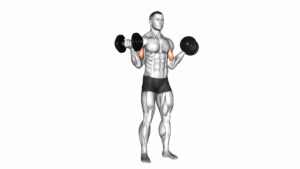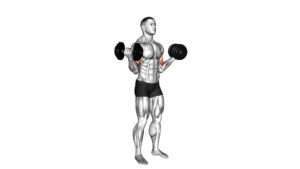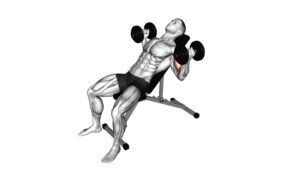Dumbbell Standing Inner Biceps Curl (version 2) (female) – Video Exercise Guide & Tips

Are you looking to tone and strengthen your biceps? Then the Dumbbell Standing Inner Biceps Curl (version 2) is the exercise for you. This video exercise guide and tips will show you the proper form and technique to maximize your results.
Watch This Exercise Video
Don't worry about finding the right weight, we'll help you choose the perfect one. Avoid common mistakes and learn alternative variations to keep your workouts interesting.
Follow our tips for increasing intensity and progressing in this effective biceps exercise. Let's get started!
Key Takeaways
- The Dumbbell Standing Inner Biceps Curl targets the inner part of the biceps for strength and definition.
- This exercise offers variations in grip and position for targeting different muscles.
- It enhances overall arm strength and aesthetics, helping to achieve a well-rounded and toned appearance.
- The exercise can be performed standing or seated, depending on individual preferences.
Benefits of the Dumbbell Standing Inner Biceps Curl
Improve your bicep strength and definition with the Dumbbell Standing Inner Biceps Curl. This exercise offers a range of benefits that can help you achieve your fitness goals.
One of the key benefits is that it targets the inner part of your biceps, helping to build strength and definition in that specific area. By performing this exercise regularly, you can develop a balanced and sculpted look for your arms.
Another benefit of the Dumbbell Standing Inner Biceps Curl is that it allows for variations in grip and position. By changing your grip, such as using a neutral grip or a supinated grip, you can target different muscles within your biceps. Additionally, you can choose to perform the exercise standing or seated, providing options for individuals with different needs or preferences.
Incorporating the Dumbbell Standing Inner Biceps Curl into your workout routine can enhance your overall arm strength and aesthetics. By engaging the inner part of your biceps, you can achieve a more well-rounded and toned appearance.
Now that you understand the benefits, let's move on to the proper form for the dumbbell standing inner biceps curl.
Proper Form for the Dumbbell Standing Inner Biceps Curl
To perform the Dumbbell Standing Inner Biceps Curl with proper form, grasp a dumbbell in each hand and keep your elbows close to your sides. This exercise is highly effective in targeting and strengthening the biceps muscles.
To begin, stand upright with your feet shoulder-width apart and your knees slightly bent. Hold the dumbbells with an underhand grip, palms facing your body. Your arms should be fully extended, with the dumbbells hanging down by your sides.
As you curl the dumbbells upwards, focus on keeping your elbows stationary and close to your sides. Avoid swinging or using momentum to lift the weights. Slowly lift the dumbbells towards your shoulders, contracting your biceps muscles at the top of the movement.
Pause briefly at the top, then lower the dumbbells back down to the starting position in a controlled manner. Repeat for the desired number of repetitions.
To maximize the benefits of this exercise, it's important to maintain proper form throughout. Keep your core engaged, your back straight, and your shoulders relaxed. Avoid excessive swinging or using your back or shoulders to lift the weights.
Choosing the Right Weight for the Dumbbell Standing Inner Biceps Curl
To choose the appropriate weight for the Dumbbell Standing Inner Biceps Curl, assess your current strength level and select dumbbells that challenge you within the recommended rep range. Choosing the right weight is crucial to avoid injury and maximize the effectiveness of the exercise.
When selecting dumbbells for the Dumbbell Standing Inner Biceps Curl, it's important to find a weight that allows you to perform the exercise with proper form. If the weight is too light, you won't be effectively targeting your biceps muscles. On the other hand, if the weight is too heavy, you may compromise your form and increase the risk of injury.
To determine the right weight for you, start with a lighter dumbbell and perform a few repetitions. If you find that the weight is too easy and you can easily complete the recommended number of repetitions, it's time to increase the weight. On the other hand, if you struggle to complete the exercise with proper form, it's a sign that the weight is too heavy.
Common Mistakes to Avoid During the Dumbbell Standing Inner Biceps Curl
To perform the dumbbell standing inner biceps curl correctly, make sure you avoid these common mistakes:
- Incorrect arm position, such as allowing your elbows to flare out or not keeping them close to your sides, can limit the effectiveness of the exercise.
- Additionally, maintaining proper form, including a controlled and slow movement, is crucial for targeting the inner biceps effectively.
- Lastly, be careful not to overload with too much weight, as this can lead to improper form and potential injury.
Incorrect Arm Position
Keep your arms close to your sides during the dumbbell standing inner biceps curl to avoid incorrect arm position. One common mistake is a lack of focus, where individuals allow their arms to drift away from their body. This can lead to a less effective workout and increase the risk of injury.
Another mistake to avoid is an incorrect grip. Make sure to hold the dumbbells with a firm grip, keeping your palms facing upwards throughout the exercise. This will help engage the biceps muscles properly and ensure a safe and efficient workout.
Lack of Proper Form
When performing the dumbbell standing inner biceps curl, make sure you maintain proper form to avoid common mistakes. Overcoming challenges and preventing injuries are essential for a successful workout. To help you achieve this, here are three key points to keep in mind:
- Maintain a stable stance: Stand with your feet shoulder-width apart and keep your core engaged to provide stability throughout the exercise. This will prevent unnecessary strain on your back and improve overall balance.
- Control your movement: Avoid swinging the dumbbells or using momentum to lift the weight. Instead, focus on controlled and deliberate movements, ensuring that your biceps are doing the work. This will maximize muscle engagement and reduce the risk of injury.
- Use the appropriate weight: Select a weight that challenges you without compromising your form. Starting with lighter weights and gradually increasing the resistance will help you build strength while minimizing the risk of strain or injury.
Overloading With Weight
Avoid using excessively heavy weights when performing the dumbbell standing inner biceps curl to prevent strain and injury. Overloading with weight is a common mistake that many people make when trying to build their biceps.
While it's important to challenge yourself and gradually increase the weight you lift, it's equally important to do so in a controlled and safe manner. Using weights that are too heavy can put unnecessary stress on your muscles and joints, leading to potential injuries.
Instead, focus on using proper form and technique, and gradually increase the weight over time. This is known as progressive overload, which is one of the most effective techniques for muscle growth. By gradually increasing the weight, you allow your muscles to adapt and grow stronger without risking injury.
Alternative Variations of the Dumbbell Standing Inner Biceps Curl
Looking for alternative variations of the dumbbell standing inner biceps curl?
Two options you can try are the cross-body hammer curl and incline bench curls.
The cross-body hammer curl targets the inner biceps while also engaging the forearms, and it can be done with dumbbells or a barbell.
Incline bench curls, on the other hand, involve performing the exercise on an incline bench, which helps to isolate the biceps and increase the range of motion.
Give these variations a try to add variety to your biceps workout routine.
Cross-Body Hammer Curl
To enhance your bicep workout, try incorporating the cross-body hammer curl as an alternative variation of the dumbbell standing inner biceps curl. This cross body biceps exercise targets not only your biceps but also your forearm muscles, providing a well-rounded workout.
Here are the benefits of hammer curls:
- Increased muscle activation: The cross-body hammer curl engages both the biceps brachii and the brachialis muscles, leading to greater muscle activation and development.
- Improved grip strength: Holding the dumbbells in a neutral grip position during the exercise helps to strengthen your grip, which can be beneficial for various daily activities and other exercises.
- Enhanced muscle balance: By working the biceps from a different angle, the cross-body hammer curl helps to improve muscle balance and prevent imbalances that can lead to injuries.
Incorporating the cross-body hammer curl into your bicep routine can add variety and maximize your gains.
Incline Bench Curls
Try incorporating incline bench curls as an alternative variation of the dumbbell standing inner biceps curl to target your biceps from a different angle and add variety to your workout.
Incline bench curls involve performing bicep curls while lying on an incline bench with your back supported. This variation helps to isolate the biceps and puts less strain on your lower back compared to the standing version.
By adjusting the angle of the bench, you can change the emphasis on different parts of the biceps muscles. Incline bench curls also engage the stabilizer muscles in your shoulders and core, helping to improve overall strength and stability.
Additionally, this exercise allows for a greater range of motion, leading to increased muscle activation and growth. Incorporating incline bench curls into your routine can help you achieve well-rounded and defined biceps while adding diversity to your training regimen.
Tips for Increasing Intensity and Progressing in the Dumbbell Standing Inner Biceps Curl
How can you effectively increase the intensity and progress in the Dumbbell Standing Inner Biceps Curl? Here are some tips to help you maximize your workout:
- Increase the weight: Gradually increase the weight of the dumbbells you're using to challenge your biceps and promote muscle growth. Start with a weight that allows you to perform 8-12 reps with proper form, and gradually increase the weight as you get stronger.
- Adjust your tempo: Varying the tempo of your reps can add intensity to your biceps curl. Try slowing down the eccentric (lowering) phase of the movement to increase time under tension, or perform explosive concentric (lifting) reps to engage more muscle fibers.
- Incorporate supersets or drop sets: To further increase the intensity of your biceps curl, consider incorporating supersets or drop sets into your routine. Supersets involve performing another exercise immediately after your biceps curl, such as triceps dips or hammer curls. Drop sets involve decreasing the weight after reaching failure and continuing the exercise with a lighter weight.
Frequently Asked Questions
How Many Sets and Reps Should I Do for the Dumbbell Standing Inner Biceps Curl?
For the dumbbell standing inner biceps curl, it's important to focus on weight selection, proper form, and technique.
Start by determining the appropriate weight that challenges your biceps without sacrificing form. Aim to do 3 to 4 sets of 8 to 12 reps for this exercise.
Remember to keep your back straight, elbows close to your sides, and curl the dumbbells towards your chest while contracting your biceps.
This will help you maximize the effectiveness of the exercise.
Can I Do the Dumbbell Standing Inner Biceps Curl With a Resistance Band Instead of Dumbbells?
Yes, you can definitely do the dumbbell standing inner biceps curl with a resistance band instead of dumbbells. Using a resistance band as an alternative provides a different type of resistance and can help target your biceps in a similar way.
However, it's important to note that using dumbbells offers the advantage of adding more weight, which can lead to greater muscle growth.
Both options have their benefits, so it's up to you to choose the one that suits your preferences and goals.
Is It Necessary to Warm up Before Performing the Dumbbell Standing Inner Biceps Curl?
Before performing the dumbbell standing inner biceps curl, it's necessary to warm up to reap the benefits. Warming up helps increase blood flow, loosen muscles, and prevent injuries.
Common mistakes to avoid during this exercise include using too much weight, swinging the body, and not maintaining proper form.
Can I Do the Dumbbell Standing Inner Biceps Curl if I Have a Previous Arm Injury?
If you have a previous arm injury, it's important to be cautious when performing the dumbbell standing inner biceps curl. Consult with a healthcare professional or a certified trainer who can evaluate your injury and provide modifications or alternatives for this exercise.
They can suggest exercises that target the biceps without putting strain on your injured arm. Remember, always prioritize your safety and listen to your body while exercising.
How Often Should I Incorporate the Dumbbell Standing Inner Biceps Curl Into My Workout Routine?
To maximize your bicep gains, incorporate bicep isolation exercises like the dumbbell standing inner biceps curl into your workout routine. This exercise specifically targets the inner biceps, helping to develop definition and strength.
However, if you have a previous arm injury, it's important to consult with a healthcare professional before attempting this exercise.
If the inner biceps is your focus, alternatives like hammer curls or cable curls can also effectively target this area.
Conclusion
In conclusion, the dumbbell standing inner biceps curl is a great exercise for targeting and strengthening the biceps muscles. By maintaining proper form and choosing the right weight, you can effectively work the inner biceps and avoid common mistakes.
Additionally, there are alternative variations and tips for increasing intensity and progressing in this exercise. Incorporating the dumbbell standing inner biceps curl into your workout routine can help you achieve stronger and more defined biceps.

Author
Years ago, the spark of my life’s passion ignited in my mind the moment I stepped into the local gym for the first time. The inaugural bead of perspiration, the initial endeavor, the very first surge of endorphins, and a sense of pride that washed over me post-workout marked the beginning of my deep-seated interest in strength sports, fitness, and sports nutrition. This very curiosity blossomed rapidly into a profound fascination, propelling me to earn a Master’s degree in Physical Education from the Academy of Physical Education in Krakow, followed by a Sports Manager diploma from the Jagiellonian University. My journey of growth led me to gain more specialized qualifications, such as being a certified personal trainer with a focus on sports dietetics, a lifeguard, and an instructor for wellness and corrective gymnastics. Theoretical knowledge paired seamlessly with practical experience, reinforcing my belief that the transformation of individuals under my guidance was also a reflection of my personal growth. This belief holds true even today. Each day, I strive to push the boundaries and explore new realms. These realms gently elevate me to greater heights. The unique combination of passion for my field and the continuous quest for growth fuels my drive to break new ground.







